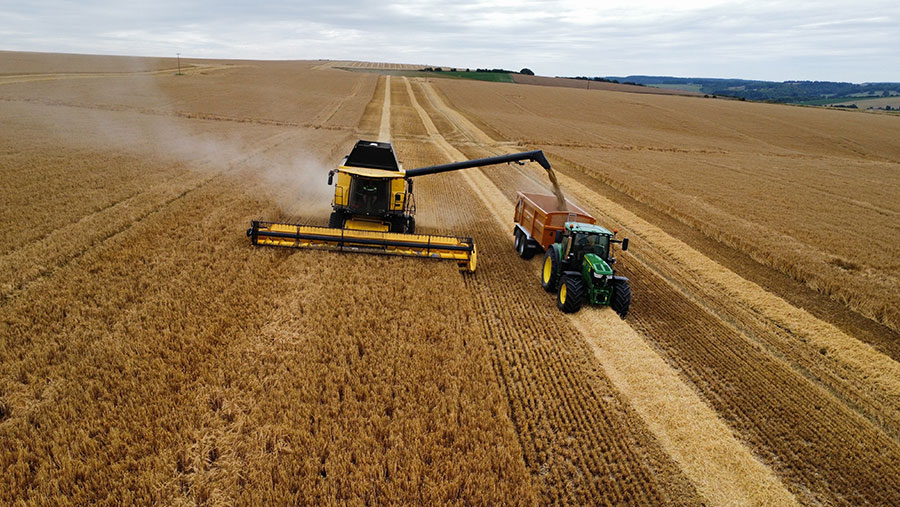Harvest 2022: Good crop yields, but some moisture deductions
 © Josh Stratton
© Josh Stratton Combines are rolling in the South as harvest 2022 gets off to an early start with dry weather keeping drying costs at bay.
However, the low moisture contents are causing problems for some growers.
Cornwall
Starting in the South West, Ashley Jones’ combine rolled into his 26ha of winter barley at Smeaton Farm on Monday (11 July), producing his best yield in three years – a promising start to harvest.
He achieved an average yield of 8.4t/ha, at about 13% moisture, with the two-row variety California, and the hybrid, Kingsbarn.
See also: Advice on reducing harvest losses in oilseed rape
“We’ve grown 50:50 of the two winter barley varieties. It’s our first year growing a hybrid and I wish I’d started sooner.
“Kingsbarn yielded around 9.6t/ha, some 2.5t/ha more than California, which I put down to it getting good growth and its roots down before the drought conditions of April/May.”
Harvest is imminent for his 26ha of hybrid oilseed rape variety, Ambassador, which in past years has produced yields upwards of 4.3t/ha.
Mr Jones is aiming to go in at about 8% moisture. “It’s a monstrous crop and this year we’ve been fortunate – no insecticide needed and no issues with slugs.”
Wiltshire
Harvest is off to a very pleasing start for Josh Stratton at East Farm, near Codford St Mary.
Having finished his 180ha of Electrum winter malting barley destined for Molson Coors, he was delighted with the yield.
“We’ve averaged 9.1t/ha, which I’m really pleased with – we’re about 15% ahead of where we forecast, which was 8t/ha,” said Mr Stratton.
Quality has been good too, with low screenings and 1.7% nitrogen.
“Bushel weights are really good at 69kg/hl, which is much higher than usual – we would normally be 62-63kg/hl. That’s where the yield is coming from – it’s the specific weights which basically all come from sunshine.”
He is now pausing for a couple of days before making a start on his 250ha of Amarone, Ambassador and Aspire oilseed rape next week (w/c 18 July).
“Aspire and Amarone are looking nice, but the Ambassador is looking fabulous; it’s a hybrid so I think the hybrid vigour is just giving it a kick,” he said.
So what does he predict for harvest going forward? “I think the hot weather is favouring the wheat, which looks fabulous, but the spring barley is looking a bit tender.”
Dorset
Heading back towards the south coast, Clive Tory at Lower Almer Farms, near Blandford Forum, is growing oilseed rape for the first time since a disastrous crop in 2019 – but this year his risk has paid off.
“Back in 2019, the whole 101ha of oilseed rape was eaten by cabbage stem flea beetle – it was a big loss,” he said.
“Last year we decided to grow again; we direct-drilled 40.5ha of the hybrid Ambassador on 21 August and harvested it this week (w/c 11 July).
“It was very early and averaged 4t/ha, starting out at 7% moisture and dropping back to 5%.”
Mr Tory is looking to enter his 81ha of Mascani oats mid next week (20 July), which will be followed by 73ha of group two milling wheat, Extase, and 77ha of group three biscuit wheat, Astronomer.
He will finish harvest on 61ha of winter beans; a 50:50 split of varieties Tundra and Vespa. “Next year we’ll just grow Vespa, it yields 8-9% over Tundra.”
Kent
Travelling on to the South East, Robert Spencer started his combine on Monday (11 July) and produced very pleasing winter barley yields – albeit with a slight moisture penalty.
“It’s been an early harvest for us; about a week early. We finished the 90ha of two-row variety Hawking yesterday (14 July) and were very pleased with yields at 9.5t/ha,” he said.
“Low moisture at 11.5% has a cost and we had some trouble in one field with about 10% wheat volunteers.”
“We’ll start oilseed rape this week (15 July) with the wheat harvest rapidly approaching – I’ll be out this weekend assessing moisture.”

